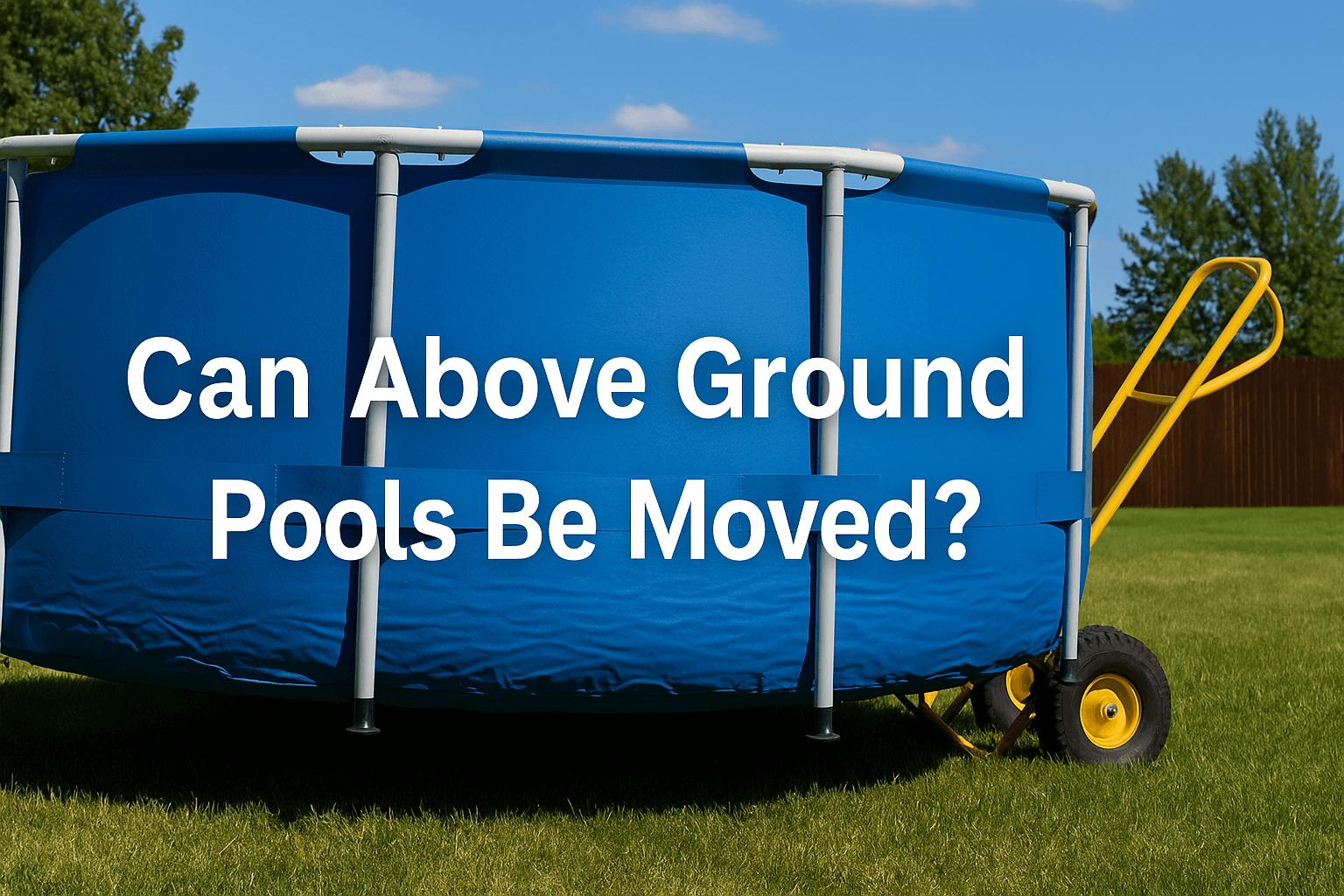
Can Above Ground Pools Be Moved?
Ever looked at your deep above ground pool and thought, "What if I just shifted it over there?" Maybe you're revamping the garden. Maybe you're moving house. Or maybe you're just craving a sunnier splash zone. Whatever the reason — yes, you can move an above ground pool! With the right tools (and a bit of patience), it’s not only possible — it’s totally doable. Stick around for practical tips, common pitfalls, and the smart way to give your pool a fresh new home.
Understanding the Feasibility of Moving an Above Ground Pool
Portability as a Key Advantage of Above Ground Pools
One of the biggest perks of above ground pools? They’re not bolted to the earth forever. Unlike in-ground options, you’re not stuck with the pool where you first built it. Think of it as garden furniture... with a bit more splashing.
With proper planning and care, many above ground pools can be taken down, packed up, and rebuilt elsewhere — whether that's another corner of the garden or a brand-new property altogether.
Factors Affecting Ease of Relocation (Size, Type, Age)
Not all pools are created equal when it comes to moving. Large pools with thick frames or heavy-duty liners might take more elbow grease than smaller, simpler ones. Pools made from steel or aluminium frames tend to handle relocation better — they’re more robust and less likely to twist or break.
Age plays a part too. A newer pool is less likely to have brittle parts or hidden wear that could turn into problems during the move.
Distinction Between Small Inflatable/Soft-Sided vs. Hard-Sided Pools
Inflatable or soft-sided pools? Easy come, easy go. These are the simplest to move — just deflate, fold up, and you’re done. But they’re also more fragile and may not last through multiple relocations.
Hard-sided pools, on the other hand, need more care. You’ll have to disassemble them properly, store the liner carefully to avoid creasing or tearing, and keep track of all the bolts and fittings. They’re tougher — but the payoff is they often last longer and offer a sturdier swim.
When Moving an Above Ground Pool is Possible
Relocating to a New Spot in the Same Yard
Rearranging your garden? Maybe you want to reclaim the patio space or shift the pool closer to the sun. Moving your pool within your own yard is often the simplest option.
It’s a great way to refresh your layout without needing a whole new setup. Just make sure the new spot ticks the same boxes: flat, well-drained, and safe.
Moving to a Completely Different Property
Taking your pool with you to a new home? It’s doable — especially if your pool is in good condition. If you're already hiring a moving van, it might just be a matter of packing it properly and making sure you’ve prepped the new location.
But a word of caution: if your pool is a few years old and showing signs of wear, it might be more cost-effective to start fresh.
Seasonal Takedown and Reassembly
Some families take their pools down each winter — especially in colder parts of the UK. If you already do this, you're well-prepped for a bigger move. The process is largely the same, just with a bit more planning and possibly a longer drive.
It’s also a good opportunity to give everything a thorough clean and check for damage before the next swim season.

The Process and Considerations for Moving an Above Ground Pool
Steps for Disassembly and Preparation
Draining and Cleaning the Pool
Start with the basics — draining the water. Connect a hose to your pool's drainage outlet and guide it to a safe place, away from foundations or flower beds. Always check local water regulations so you're not caught out.
Once drained, give the liner a good clean. This helps avoid dirt, mould, or sharp grit scratching it during storage.
Careful Disassembly of Walls, Frame, and Liner
Take your time here. Remove the liner carefully — it can be reused if treated gently. Disassemble the frame, working methodically and following the manufacturer’s instructions if you still have them.
Keep an eye out for any rusted parts or stubborn fittings. A bit of WD-40 can work wonders. And remember — slow and steady wins the race.
Packing and Protecting Components
Organisation is your best friend. Label parts as you go, and group similar pieces together. Screws, bolts, and clips? Pop them into clearly labelled bags.
Wrap the liner in a soft cloth or tarpaulin to avoid damage, and don’t stack heavy things on top of it. Think of it like packing up a giant, watery jigsaw.
Site Preparation at the New Location
Ensuring a Level and Stable Base
Before anything goes up, make sure your new site is level. Use a spirit level to check. Even slight tilts can put uneven pressure on the pool walls, which isn’t safe.
A compacted layer of sand or fine gravel works well for levelling. Steer clear of rocky or root-filled patches.
Addressing Drainage and Sun Exposure
Drainage is key. You don’t want water pooling under the pool base after every rainfall. Make sure the site allows rain to flow away naturally.
And sunlight? Pick a spot that gets enough to warm the pool water — but not so much that the kids burn their feet on hot decking.

Challenges and Risks of Moving
Potential for Damage to Liner or Frame During Disassembly/Reassembly
Let’s be honest — things can go wrong. Liners are vulnerable to small tears if scraped or folded roughly. Frames can get bent, especially if they’ve got any pre-existing rust or wear.
Take extra care when handling these parts. And don’t skip the protective wrapping.
Wear and Tear on Components
If your pool’s seen a few summers, expect some wear. Screws might be stripped. Plastic parts may have weakened in the sun.
Replacing small items ahead of the move can save a headache later. A missing bolt or broken leg bracket is the kind of thing that turns a Saturday job into a weekend saga.
Professional Assistance vs. DIY
Not a DIY fan? Some pool owners choose to hire pros — especially if the pool is large or if time’s short. Yes, it’s an added cost, but it can make the whole process faster and safer.
For confident DIYers though, it’s entirely doable — just plan ahead and rope in a mate or two for the heavy lifting.

When Moving is Not Recommended
Very Old or Deteriorated Pools
If the pool’s already limping along with patches and wobbly supports, moving it might not be the best idea. It could fall apart halfway through, leaving you with a pile of parts and no pool.
In these cases, consider retiring it gracefully. Then invest in a new setup for the new location.
Complex Custom Installations (e.g., Integrated Decks)
If your above ground pool is built into a custom deck or landscaping feature, moving it becomes a whole different beast. It’s not just about the pool anymore — it’s about the whole setup.
Dismantling custom features takes time, money, and sometimes even permits. In many of these cases, it’s easier to leave the pool behind and start fresh.
With the right prep, tools, and mindset, moving your above ground pool can be smoother than you think. Whether it’s a deep hard-sided setup or a quick seasonal soft pool, there's a way to take it with you. Just plan ahead, protect the parts, and don’t forget to leave space in the garden for a deckchair or two.
Time to make waves somewhere new!
Have you checked out our other posts?
Can You Put An Above Ground Pool In The Ground?
Can Above Ground Pools Be Put On Concrete?
Does An Above Ground Pool Need A Pump?


Leave a comment